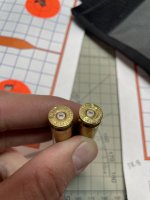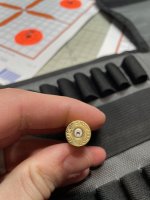Hey all, Im sure pressure signs are asked about ad nauseam. But I am stuck wracking my brain on why I am seeing what Im seeing.
Im loading for a 6 creed, 115dtacs, Alpha (non-OCD) SRP brass, CCI 450’s and H4350. These are being shot through a Zeus Action and 26” 1:7.5 twist barrel. Approx 400rnds down the pipe.
Bullets jumped .02, all brass is once fired, and has been annealed on an AMP. .002 shoulder bump, necks turned to .0135 and primer pockets uniformed.
I have found that regardless of the charge I get varying levels of pressure signs. I see ejector marks on every piece I shoot, and primer cratering on loads as low as 37.6gr
Recently I blew 2 primers at a match, and decided to go back to the drawing board. I cleaned the barrel well (no carbon ring) and restarted load development to see what was the issue. During the testing the barrel was allowed to cool for 5 min between groups, and I began to get sticky bolt lift at 38.2gr The test ranged from 37.0gr to 38.8gr. Speed of the 37.0gr loads were 2848fps, and the 38.8gr loads were and average of 2953fps.
Attached are photos of a 37.0 piece and some of the 38.8 pieces.
Thanks for your help
Im loading for a 6 creed, 115dtacs, Alpha (non-OCD) SRP brass, CCI 450’s and H4350. These are being shot through a Zeus Action and 26” 1:7.5 twist barrel. Approx 400rnds down the pipe.
Bullets jumped .02, all brass is once fired, and has been annealed on an AMP. .002 shoulder bump, necks turned to .0135 and primer pockets uniformed.
I have found that regardless of the charge I get varying levels of pressure signs. I see ejector marks on every piece I shoot, and primer cratering on loads as low as 37.6gr
Recently I blew 2 primers at a match, and decided to go back to the drawing board. I cleaned the barrel well (no carbon ring) and restarted load development to see what was the issue. During the testing the barrel was allowed to cool for 5 min between groups, and I began to get sticky bolt lift at 38.2gr The test ranged from 37.0gr to 38.8gr. Speed of the 37.0gr loads were 2848fps, and the 38.8gr loads were and average of 2953fps.
Attached are photos of a 37.0 piece and some of the 38.8 pieces.
Thanks for your help


